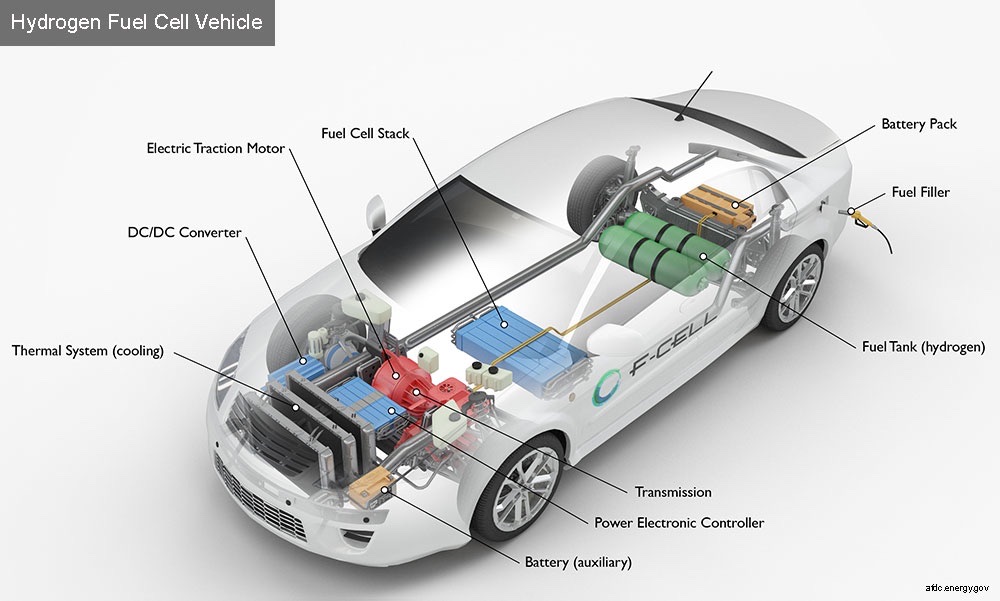
Fuel cell electric vehicles (FCEVs) are similar to all-electric vehicles in that they use electricity to power an electric motor. However, unlike all-electric vehicles that draw electricity from a battery, FCEVs generate their own electricity using a fuel cell powered by hydrogen. The vehicle manufacturer designs the power system, which includes both a fuel cell and a battery, to provide optimal performance. The battery in FCEVs is typically used for recapturing braking energy, providing extra power during acceleration, and smoothing out power delivery. The hydrogen fuel tank size determines the amount of energy stored onboard.
Key Components of a Hydrogen Fuel Cell Electric Car
- Battery (Auxiliary):
- Provides electricity to start the car before the traction battery is engaged and powers vehicle accessories.
- Battery Pack:
- Stores energy generated from regenerative braking and provides supplemental power to the electric traction motor.
- DC/DC Converter:
- Converts higher-voltage DC power from the traction battery pack to the lower-voltage DC power needed to run vehicle accessories and recharge the auxiliary battery.
- Electric Traction Motor (FCEV):
- Drives the vehicle’s wheels using power from the fuel cell and the traction battery pack. Some vehicles use motor generators that perform both the drive and regeneration functions.
- Fuel Cell Stack:
- An assembly of individual membrane electrodes that use hydrogen and oxygen to produce electricity through an electrochemical reaction.
- Fuel Filler:
- A nozzle from a hydrogen dispenser attaches to the vehicle’s receptacle to fill the tank with hydrogen gas.
- Fuel Tank (Hydrogen):
- Stores hydrogen gas onboard the vehicle until it’s needed by the fuel cell.
- Power Electronics Controller (FCEV):
- Manages the flow of electrical energy delivered by the fuel cell and the traction battery, controlling the speed of the electric traction motor and the torque it produces.
- Thermal System (Cooling) – (FCEV):
- Maintains a proper operating temperature range for the fuel cell, electric motor, power electronics, and other components.
- Transmission (Electric):
- Transfers mechanical power from the electric traction motor to drive the wheels.
How Fuel Cell Electric Vehicles Operate
- Hydrogen Storage:
- Hydrogen gas is stored in high-pressure tanks within the vehicle. These tanks are filled at hydrogen fueling stations.
- Electricity Generation:
- The fuel cell stack generates electricity through an electrochemical reaction between hydrogen (from the tank) and oxygen (from the air). This process produces water as a byproduct, emitting zero harmful emissions.
- Energy Management:
- The power electronics controller regulates the flow of electricity from the fuel cell and the battery to the electric motor, optimizing performance and efficiency.
- Regenerative Braking:
- Energy from braking is captured and stored in the battery pack, which can then be used to assist in powering the vehicle.
- Power Delivery:
- The electric traction motor, powered by the fuel cell and battery, drives the vehicle’s wheels. The transmission system helps transfer this mechanical power to the wheels efficiently.
Advantages of Fuel Cell Electric Vehicles
- Zero Emissions:
- FCEVs emit only water vapor and heat, contributing to reduced air pollution.
- Quick Refueling:
- Hydrogen refueling takes a similar amount of time as refueling a conventional gasoline vehicle, typically around 3-5 minutes.
- Long Range:
- FCEVs can offer a driving range comparable to conventional gasoline vehicles, typically between 300 to 400 miles on a full tank.
- High Efficiency:
- Fuel cells are generally more efficient than internal combustion engines, converting more energy from fuel into usable power.
Challenges and Considerations
- Hydrogen Infrastructure:
- The availability of hydrogen refueling stations is currently limited, which can affect the practicality of owning an FCEV.
- Production and Storage of Hydrogen:
- Producing hydrogen in an environmentally friendly way and storing it safely are ongoing challenges.
Fuel cell electric vehicles represent a promising technology for achieving sustainable and zero-emission transportation, with ongoing advancements aimed at overcoming current limitations and expanding their adoption.
